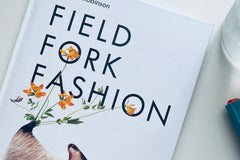FIELD FORK FASHION BY ALICE V ROBINSON

Online talk via the Fashion & Costume Museum
18th Jan 2024
Personally, I love leather, it is such a beautiful fabric, so strong and durable. But, how ethical is it? In a world of fast fashion, we've lost sense of the realities of how things are made, and the processes required to get there. Traditionally, leather was a by-product of the meat industry, but these days, there are factory farms that breed livestock in specific ways to get the best quality leathers they can, or to meet demand of the meat industry. We seem to have lost the connection of leather to agriculture. Alice V Robinson has written this book "Field, Fork, Fashion" to explore the traceability of the material's agriculture, and what its relationship could mean for design and sustainability.
As a designer, Alice had a lot of questions regarding the relationship between food and clothing. Leather originates in food systems, and so she needed to confront its transformation as a product in the field into food and fibre.
In 2018, the V&A museum invited Alice to exhibit "Collection 11458" in the 'Waste' section of their exhibition "Food: Bigger Than The Plate". Collection 11458 consisted of five items: a jumper, a pair of gloves, a bag, a pair of shoes and a purse. All the material from sheep 11458. Aesthetics defined by the qualities allowed of the breed. The breed chosen by the farmer that deemed it best for their business. A challenging limitation for a designer.
Describing leather as 'a by-product of the meat industry' prompted further questions. Leather wholesalers would not be able to tell where the origins of the leather came from. As the leather is created through a complex process, it passes on from factory to factory thus loosing its traceability in the supply chain.
The fours stages of producing leather are: the farm, the abattoir, tanning and making. All stages dependent of factors pertained to each industry.
Most leather used in fashion accessories come from cattle. Alice purchased a Bullock 374: a Longhorn Limousin cross from a local farmer who would be taking his cattle to an abattoir in the coming months. A local farmer in Halghton, Malcolm Adams is the third generation of Charity Farm. With clay soils and rich pastures providing a supply of food for grazing cattle, ancient hardy breeds were brought in support the farm's ecosystem and conservation work. Malcolm's approach to farming is to tread lightly, working with nature.
At the abattoir, the farmer is paid for a carcass including the meat and bones. In her book, Alice has a detailed diagram indicating each cut of meat and where it went, predominantly keeping it within the local community. The hide along with the horns, feet, fat and offal are owned by the abattoir to be sold on, making additional revenue. The abattoir that Alice went to is one of small-scale, and does not produce enough hides to make it worth their while, and so they are waste and will incur cost to dispose of, and so were happy to return the hide to Alice. A common misconception is that farmers sell cattle for its hide, when it is actually the abattoir that owns them, and choose whether to sell it.
Tanning. There are 2 methods of tanning: chrome or vegetable. Chromium salts can create brighter colours but can also leach toxic chemicals if not treated properly. Vegetable tannins reveal all the marks, scars, bite marks etc in a hide. Both methods cater for different requirements.
Only 6 out of the remaining 23 tanneries in Britain could process raw cattle hide. Alice was unable to find a tannery that could use vegetable tanning on a single hide, but managed to find a company willing to trace every step of the chrome tanning (as hides look identical during the process). To enable this, Alice chose to slice the hide down the centre of its spine. So it would be the only half hides inside the tannery. One side kept its hair, the other would have its hair removed.
Making products from the hide were subjected to the outcome of the tannery, limited by its quality and its size. The hide is split into 2, the full grain and the suede (closest to the meat). Alice was left with 1 piece of leather, 1 piece of hair-on leather, and 2 pieces of suede. Design decisions were dictated by where any marks were, and by the size of the piece and its consistency. The collection would comprise a coat, a jacket, 3 pairs of shoes and 2 bags. Any leather leftover would be made into small leather goods, designing as she went along. The bones and horns were made into hardware; buttons and clasps throughout the collection.
Bullock 374 was shown at the V&A exhibition, with a private viewing the night before opening, that served charcuterie made with 3 joints of silverside of Bullock 374.
Alongside Sara Grady, Alice is working on British Pasture Leather which hopes to value the material more than a commodity. Managing land biodiversity with a diverse range of grasses, diversifying farmers' offerings against the big supermarket giants. Coordinating abattoirs to retain all traceability, and continuing a traditional vegetable tanning process in a British tannery, and finished in a British company that uses natural methods resulting in a biodegradable leather.
I was fascinated by the entire process of Alice's journey, and immediately bought her book to read all the finer details. I now value my leather products even more than before, and have a good inquiring mind whenever I see leather products on offer. A recommended read, 'Field, Fork, Fashion' should be available wherever you normally buy your books from!
------
Source:
Robinson, A. V. (2023) Field, Fork, Fashion, Chelsea Green, London.
Please note: A KIND CLOTH is in no way affiliated with the aforementioned products, all opinions expressed are the author's own.
